SOUTHEAST TINES



















PRESIDENT
James “Smitty” Smith
Gum Creek Hunting Preserve
813-714-5045
Jsmith@crossenv.com
www.GumCreekHuntingPreserve.com
VICE PRESIDENT
Dr. Bill Leffler



2 Base Down Farms PO Box 159 Morriston, FL 32668 561-373-2353
Bleffler2011@gmail.com
Twobasedownfarms@yahoo. com
TREASURER
Dr. Juan Campos College of Veterinary Medicine
Dept. of Large Animal Clinical Sciences
University of Florida
108 Deriso Hall, Gainesville, FL 32610
352-363-0703 / jmcampos@ ufl.edu
- these are interactive links in the eBook that is sent out to all members
This symbol indicates there is a video linked
DIRECTORS
Benny Wilkison
Lil Oak Whitetails 3193 NW 216th St Lawtey, Fl 904-424-7233
liloakwhitetails@yahoo.com
Mike Hunter MS Hunter Farm 8479 Puckett Rd Perry, FL 32348 850-843-0881






Mike.Hunter@etranscarriers. com
Louis Scott
Scott’s Game Farm
96769 O’Neil Scott Road Fernandina Beach, FL 32097 904-557-8940, 904-753-4091
Tim Cromwell
18015 NE CR 1471 Hampton, FL 32044 352-727-9528
Mike Vizcaino 149 Sand Lake Dr Pomona Park, Fl 32181 904-814-7214
Mvizcain@bellsouth.net
Ryan Boyd
Quick Catch 12627 San Jose Blvd. Suite 205 Jacksonville, FL 32223 904-859-6585
www.Quick-Catch.com
This symbol indicates there is a link to an email, website, or facebook page


Summer in Florida is known for hot rainy days, bugs, family vacations and tourists. However, to deer farmers it is probably the most exciting time of the year with the fawning season and watching our bucks grow those big beautiful racks.
I can’t help you with the heat, rain, or tourists, but you will find a brief article in this issue of Southeast Tines about bug control which you may find beneficial.
I truly hope that everyone has had an exciting and fun fawning season with little stress or sadness. As summer comes to an end, so does the growth of antlers. The rewards of food supplements have helped our bucks to reach their maximum potential and are also vital for our lactating does.
We as deer farmers often know what to expect , but should the unexpected occur, remember that your Board and I are always here to help.
With that said, the “unwanted and unexpected” has finally arrived in Florida, CWD. It was discovered in Holmes county early this year in a 4.5 year old wild (non-captive) deer. Your Board and I have been working with USDA and FWC, to make sure they are aware of our concerns as captive deer farmers and preserve owners. We have also been working hard to keep you and our members informed, on our new Website and Facebook page, about the latest information as it develops.
At this year’s SETDA Summer Picnic, there will be members from USDA and FWC to discuss CWD. There will be brief presentations and updates from UF CHeRI, as well as education concerning the nutritional needs of whitetail
deer at various stages in their life. For the first time, SETDA will have a dart gun competition. Ladies and gentlemen, if you want the braggin rights..... put your money where your mouth is! May the best shot win. As always there will be great food and fellowship, a gun raffle, discount vouchers for deer feed and dart guns, and if time permits a roundtable Q&A to your Board about the Business of Deer Farming and Hunting Preserves.
SETDA now has accounts at both Champion Genetics and Great Lakes Sire Semen storage for all semen donations. Your Board and I, want to thank all sponsors, donors, consignors, advertisers, booth sales, and our family of deer farmers and preserve owners for making the SETDA Spring Fling a success. Before you know it we will be reaching out once again for your continued support.
Your Board of Directors and I, want to remind everyone that all memberships are on a calendar year basis, January 1 thru December 31. It has also come to our attention that FWC is way behind in approving GFL and HP/BHP licenses, so go online and renew earlier than you ever have in the past. Please check out our “new” website. We have been working hard to make it much more user friendly. You can also find us on Facebook. We want to make it as easy as possible for you to be able to communicate with your Board about any issues or concerns. We are here to HELP AND SERVE YOU.
We can accomplish great things, like our Student Scholarship program, with your active support and participation. To quote a friend of mine, “Step Up and Get You Some”.
Stay Safe, Well, and “Florida Strong”
God Bless
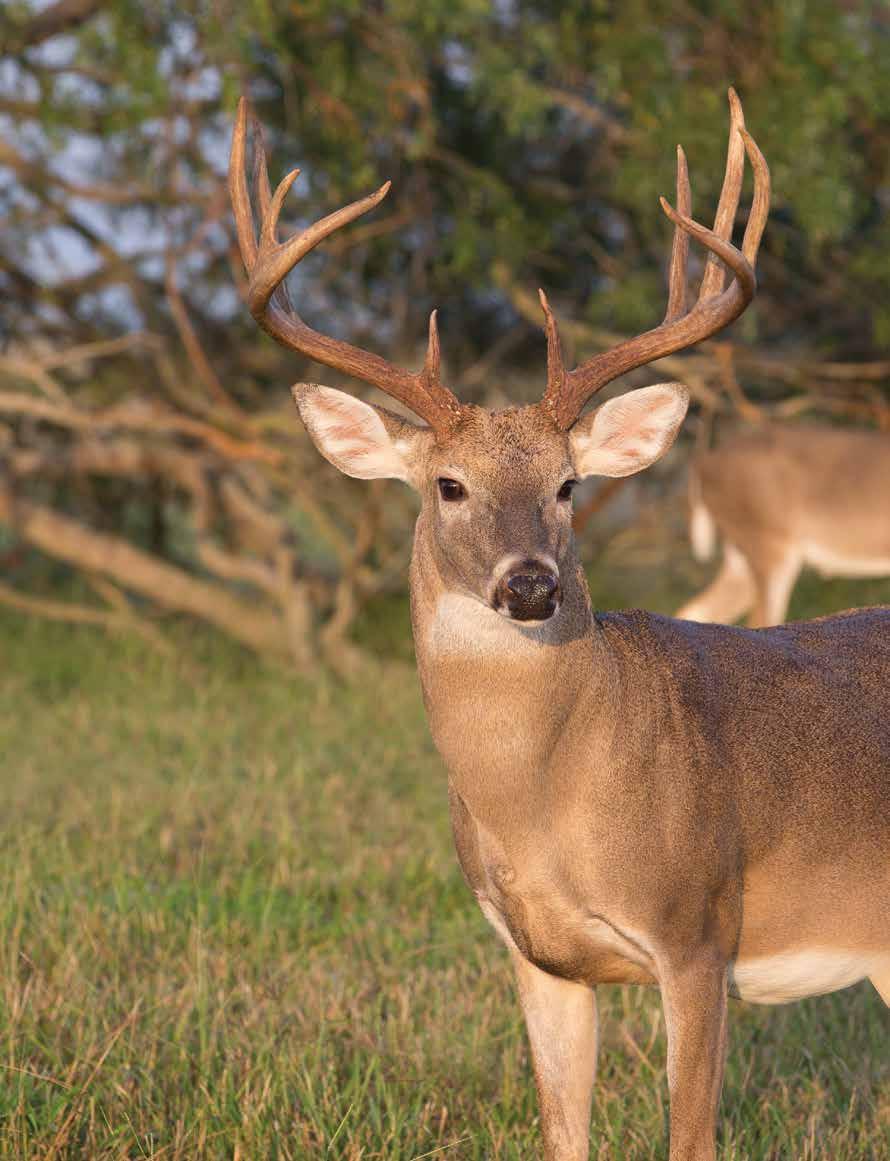
Our disposable RDDs are shorter in length and the lightest on the market thereby providing the ultimate accuracy while reducing the potential for problematic hematomas. Our Slo‑Inject® technology means that your medicine is delivered in the most effective manner possible. Pneu-Dart. When you can’t afford to miss.®


Labels are legal documents that provide information for the safe preparation and use of pesticides.

Research shows that not following directions from the label reduces the effectiveness of the pesticide (Bagheri et al. 2021)
Labels give you directions on what to do if you are exposed to the pesticide.
Product generalities:
- Product name
- Product type (i.e. pesticide)
- EPA registration number and establishment number: to indicate if the product has been approved for sale by the Environmental Protection Agency (EPA), and to identify the facility where the product was produced
- Manufacturer name and address





What is in the product?
- Active ingredient: The chemical that is responsible for controlling the pest (i.e. permethrin)
- Common name
- Chemical name

- Inert ingredients
How can this product be used safely?
- Hazards to humans and domestic animals
- Environmental hazards
- Physical and chemical hazards
- First Aid: Always call the National Poison Center Hotline (1-800-222-1222) for medical instructions
Directions for use
• What pests the product is registered to control
• How to apply the product
• How much product to use
• When and how often do you need to apply
• When is safe to re-enter a treated area after application
This section of the label will indicate how this product should be stored and what should you do with any leftovers, or with empty containers. Keep the products in their original containers, out of the reach of children, and domestic animals.
Pesticides can enter your body through:
• Your skin
• Your eyes
• Your nose
• Your mouth
How toxic is the product?
DANGER
Highly toxic
WARNING
Moderately toxic
CAUTION
Mildly toxic
Did you know that…
The label should be read at least four times:
- Before purchasing
- Before mixing
- Before applying
- Before storage or disposal
Health effects include:
• Skin/ eye irritation
• Hormone imbalance
• Cancer
• Liver damage
• Reproductive effects
Wear protective clothing and personal protective equipment to prevent exposure to pesticides
Authors: Vilma Montenegro, MS; Eva Buckner, Ph.D.; Nathan Burkett-Cadena, Ph.D.
Florida Medical Entomology Laboratory, University of Florida.








A big thank you to everyone who participated in the spring fling this year!




The clock was close to striking midnight when Jake Anderson set out for an eastern Kentucky elk hunt in September of 2013. This trip would be one of several he would take in an effort to not waste the coveted elk tag he had drawn from the Kentucky Department of Fish and Wildlife lottery earlier that summer. His plan, along with packing his hunting bow and camping gear, was to arrive at daybreak to scope out promising areas for the harvest.
“The maps provided by fish and wildlife were terrible,” Anderson, who was 25 at the time, said. And even though he stopped at several places to ask the locals about elk sightings “no one could tell me anything,” he added. “This was all on public land with no guide.” It took five trips. The first was with one of his hunting friends. Although on that trip Anderson squarely landed an arrow into a really sizable bull, the big elk was completely unfazed by the shot and continued on chasings cows, until completely disappearing from sight. His fifth trip found him shooting a fatal arrow into what Anderson still
considers his “once-in-a-lifetime” freerange elk. Luckily, the elk had expired on a dirt road on land formerly used for mining, and Anderson was able to bring his truck into the exact location and load the entire body into his truck bed.

Ironically, as he arrived to this particular spot to gather his elk, he found five elk standing right there, all bigger than the one he had just taken down. “I thought ‘you gotta be kidding me. This is just my luck,” Anderson said, even though he was really happy with his hunted treasure. During another hunt, a whitetail hunt in Kansas, both Anderson and his uncle had shot an arrow at a buck. Anderson, however, had taken and landed the first shot. Both men, upon searching for their deer, thought that their arrow had certainly been the fatal one. However, when they found the buck, only one arrow was in it. “That was another memorable hunt that really stands out for me,” Anderson said.
Yet, in all the hunting adventures he’s enjoyed throughout the years, Anderson has noticed one thing. Public land for hunting decreases every year.
According to internet research, rapid urban sprawl has been responsible for close to 14,000 square miles of land development between 2001 and 2019, which comparatively is an area roughly five times the size of the State of Delaware. Real estate values for farmland have also increased substantially throughout recent years, making selling the land more enticing particularly in states such as Pennsylvania, Ohio, Michigan and Florida. Other states experiencing the most accelerated urban growth have included Texas, Illinois and North Dakota. “Unless you own land or are leasing it, our opportunities to hunt in open range are going to be gone,” Anderson, owner of Anderson Whitetails in Guston, Kentucky, said. “There is less and less land to hunt and we are going to get to a point where there will be no place left to hunt. This is where we are lucky to have high fence hunting. You could hunt your whole life and never have the opportunity to shoot one like you have in a preserve.”
“Without high fence hunting, it is so hard for an individual to find somewhere to hunt that’s not developed or leased out,” Anderson emphasized. “If I visited a preserve, I’d like to get another elk. Same for other hunters. It wouldn’t have to be just a whitetail. You might be sitting in a deer stand an elk goes walking by and you change your mind and want one of them instead. And you wouldn’t have to go through the hassle of entering a lottery and getting a special tag. Preserve owners are playing a vital role in current and future land conservation, and in providing the sustained opportunities to enjoy unforgettable hunts.”

Iguess there are several reasons why someone would choose to trap, and there are many methods to use when you do. Biologist trap animals of all kinds to study, track their movements and better understand them. Some trappers enjoy the art of trapping to collect furs to sell in the clothing market. Still other trappers do ADC (Animal Damage Control) for others who are having problems with animals on their property. The last form of trapping (off the top of my head) that comes to mind is predator control trapping. This is a form of trapping to remove predators that are destroying the animals on game preserves and deer farms, both adults and offspring.
I fall into a couple of the above categories; I do some ADC work in all the neighborhoods around town, but I mostly enjoy the predator control aspect on the Deer Farms, Game Preserves, Exotic Ranches and Cattle Ranches. This involves mostly trapping coyotes, but sometimes bobcats find their names on the request. Although beavers are not considered predators, their activities can flood crops and pastures so I am sometimes called on to remove them. If given my choice of it all, I’d rather match wits with the coyote.
Coyotes are true survivors and are very smart when it comes to carving out a living in their home ranges. They will time their breeding and birthing seasons to match the times when fawns are born. In Florida, the coyotes are usually birthing (FebApr) & raising pups (May-Jun) when fawns are hitting the ground. Many deer farms will lose several fawns a year because the local coyote populations are trying to raise up their pups. This is very costly to the deer farmers, as each fawn can potentially bring thousands of dollars when sold at market. An

average litter of pups may be six to seven with a survival rate around four or five, if the parents can find enough food for them. Studies have shown that a mating pair of coyotes can bring down as many as 19 fawns in the wild while raising a family. Now imagine if those fawns were being raised in a pen and the coyotes found them.
When I trap on cattle ranches, it’s usually during the winter months (Dec/Jan) because if you’re after coyotes, that’s the best time. This would hold true for Deer Farms, Game Preserves, & Exotic Ranches too. I know this is not the time when your fawns are born, but it is the best time to remove the most predators. Not only coyotes & bobcats, but raccoons & possums are predators too. They will destroy and eat the eggs of every turkey nest they find and can even attack/ stress deer if cornered.
Not to say that you should not trap during the time your fawns are born, because it will be another way to protect them, but here’s a couple thoughts on winter trapping. If you catch more predators from your area during the winter, there will be less of them to kill this years fawns. When trapping in the winter, there is a good chance that you’ll catch the breeding pair and therefore stop the production of more coyotes. With all this being said, if you can safely trap during your fawning season, I would.
In all the above scenarios, I will first set up traps around the pens where the fawns will be born, never inside those pens. Then I will work my way out away from the pens towards the property boundaries looking for the most likely routes coyotes will take to and from your fawns. I will also be looking for sign (tracks, scat, scratch offs, etc...) left by the target animals. If the sign
changes (and it probably will) I would possibly have to change my strategy by moving or adding traps. A trapper who keeps his eyes open will be more successful; keeping in mind that the coyote will also notice the changes in activity and probably change his tactics.

Every day, I will be riding around the property watching for any coyote sign. I continually ask myself, “have their movements/patterns changed?” “Has one area gone cold while another area is now active?” I have to always be watching what’s going on so I can make changes where needed to take advantage of the opportunities that are given me. The coyotes are also noticing changes, like traffic in areas that are usually not traveled, or some of their local population is no longer around. This problem of outwitting each other is survival for them, and protection for your animals, for me. Needless to say the deer farmer is pulling for me.
For example, just the other day a game preserve manager called and told me he found another yearling buck (recently released onto the preserve) that had been killed by coyotes just outside of the breeding pen where he was born. When I arrived, I noticed it was a fresh kill
Continued on page 17...


and figured the culprits would be back to feed again. I moved the carcass to a safer location (where I wouldn’t disturb anything going on inside the pen) then wired it to a stump so it wouldn’t be dragged away. Five leg hold traps were set in areas of approach and on the first night I picked up a rather large male coyote. The set was remade and caught a mature female the second night. Who knows if this was a breeding pair or even if they were the ones that killed the buck, but it is two coyotes that won’t kill any more of his deer.
Trapping coyotes is not as easy as most would think, especially if you’re after all of them in a given area. Most trappers can pick up the young ones, or the ones that have never had trapping pressures put on them, but the smart and/ or educated ones are always a challenge. I keep my notes on where and when I’ve made catches. I watch the movement patterns and make notes of areas of activity. When I make a catch, I watch to see
if the sign dries up, or if there is another coyote still there. I believe that a good trapper will work hard for his client and do the best job he can. When you complete the job, and pull all your traps, the deer farmer will not only be satisfied, he’ll know who to call next time. A bonus of a good working relationship is that the client you just trapped for will pass your name and number around to his friends.
As I wrap up my thoughts on this, I should also share with you a couple more challenges to overcome when trapping coyotes that kill your animals. Every farm is different. Each deer farmer or ranch owner has his own thoughts of what he/she wants or expects the outcome to be. Each location has its own challenges and every coyote population has their

own way of doing things. I enjoy everything involved with trapping these animals and assisting the owners in keeping as many fawns as possible. The people I meet are always interesting; the trapping is a challenge and there’s never an end to the beauty of Mother Nature. Keep an eye out for the next article in the Preditor Trapping Series!
Mark Neely 904-613-3344
my243rem@yahoo.com


SETDA is taking steps to ensure that the deer industry remains a sustainable and viable lifestyle for future generations. Scholarship funds are acquired through money made at state association auctions as well as donations from members.
Qualifications for consideration for those wishing to apply for the scholarship include the intention to attend or to be presently enrolled in a college located in the southeast portion of the US. An applicant’s career plans should include involvement int he deer industry among other stipulations such as prior experience in a wildlife field pertaining to deer, academic excellence, financial need, letters of recommendation, and involvement in agricultural- related activities and organizations.
Those interested in donating to the SETDA Scholarship Fund or interested in applying please contact:




A big thank you to everyone who participated in the spring fling this year!
















The rules for sudoku are simple.

A 9x9 square must be filled in with numbers from 1-9 with no repeated numbers in each line, horizontally or vertically.
To challenge you more, there are 3x3 squares marked out in the grid, and each of these squares can’t have any repeat numbers either.

Send in this picture with your childs name and age for a chance to be featured in the next magazine or on our facebook page!
All ages welcome to participate!
Pictures can be emailed to deerassociations@gmail.com or mailed to Samantha Uchytil
19291 59th St NE
New London, MN 56273
Be Creative and add in a background for Bunny!


Deliciously marinated grilled venison kabobs – the perfect summer grilling recipe for your venison steak or tenderloin. Pair them with your favorite vegetables and you have a quick and easy weeknight wild game dinner.

• 1 lb. venison tenderloin tips or sirloin steak cut into chunks

• 1/4 cup olive oil
• 1/4 cup liquid aminos or soy sauce
• 1/4 cup Worcestershire sauce
• 1 tsp. minced garlic
• 1 Tbsp. Dijon mustard
• 1 Tbsp. brown sugar
• 1/2 tsp. cracked black pepper
• 1/2 Tbsp. lemon juice
• 8 oz. whole mushrooms
• 32 oz. bag mini sweet peppers
1. Combine the olive oil, liquid aminos, Worcestershire, minced garlic, Dijon mustard, brown sugar, pepper, and lemon juice in a bowl in a bowl and whisk together.
2. Add the tenderloin tips to the marinade and let marinate in the refrigerator for 30-60 minutes.
3. Preheat the grill to medium heat or 350 degrees F.
4. After the marinating time, remove the tenderloin tips and place them on their own skewer, separate from the veggies.
5. Add the sweet peppers and whole mushrooms to the skewers. Tip: keep veggies on their own skewer to allow correct cooking time for both the veggies and the steak.

6. Grill the tenderloin tips until they reach medium-rare – about 130-135 degrees F. Remove from grill.
7. Grill the veggies until soft and tender. Remove from grill and serve immediately.
8. Serve with your favorite steak dipping sauce.


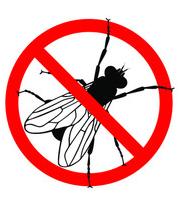

As I said earlier, summer brings hot rainy days and lots of biting bugs.
This is only a brief list and there are many other agents/things that also work, but if you have not tried the following you may want to look into it.

ANTS
Extinguish ant bait
Permethrin spray

MOSQUITOS & MIDGES
Mosquito dunks (the sinking type)
Permethrin fogging
FLIES
Fly Predators
SimpliFly Feed Thru
Fly traps (caution, can attract unwanted predators)
TICKS
Guinea Fowl
These work well for us, Good Luck
Dr William “Bill” Leffler, Jr




 By: Gail Veley • Sponsored by SETDA
By: Gail Veley • Sponsored by SETDA
Pre-thinking your strategy in raising deer is the most important thing a person can do when starting a deer farm, offers SETDA Vice President Bill Leffler, owner since 2017 of 107acre Two Base Down Farm in Morriston, Florida. “There are so many different questions to answer before you even begin to design your property or build your pens,” Leffler, 65, emphasized. “For example, are you going to A.I.? If so, how are you going to achieve this? How are you going to separate young deer from older ones? Are you going to cut buck horns? Are you going to bottle feed? How are going to protect bottle fed babies? Are you going to sell stockers or breeders? How are you going to get water and feed into your buck pens when they are in the rut? How many deer can your farm handle? What does the future hold for you and those deer? Are you willing to wait three or four years before you make a profit? Have someone experienced guide you through those questions before you design pens or build facilities and your deer arrive.”

Acquiring bred does is a common practice when deer farmers start up their farms. Leffler encourages everyone to follow this advice, and
recommends everyone buy the best genetics they can, even if it might mean only buying three or four does instead of 10 or 12. While Benny Wilkison, owner since 2011 of 10-acre Lil’ Oak Whitetails in Lawtey, Florida shares these sentiments, he would have taken it a step further. “When I bought my bred does, I promised the guy he could have all the buck fawns. I shouldn’t have done that,” he said. And while the deer on Wilkison’s farm today possess pedigrees with the likes of Back in
Wilkison, 67, explained. Keeping deer alive not only comes down to efficient pen design, but in raising deer that remain as calm as possible. At Leffler’s farm, he makes a practice out of pulling very select doe genetics to bottle feed, and appropriately mixing them when the time is right, with other non-bottlefed deer. “Many of our bottle-fed deer are so calm that they meet us at the gates, chase and follow golf carts and a few will curl up next to us. This will calm down an entire pen of both does or bucks. It makes a huge difference.”
Black, Masterpiece, Have Mercy and Get Rhythm, he spent hard earned money and time phasing out his deer he acquired early on with inferior genetics. “I also wish I would have done A.I. earlier,” he said. “I spent the first three years doing live cover with average genetics. If I had to do over, I just would have bought really good does and kept everything. Good doe genetics are key.”
Although acquiring superior genetics and raising a superior breeding buck may be the goal of many deer farmers as well, Wilkison believes it might prove just as profitable to sell them. “The one thing I’ve learned is if someone offered me a reasonable price for a deer, I would take it. They die too fast,”
Prior to having deer delivered, Leffler also strongly believes in fencing in as much of your perimeter as you possibly can, while also ensuring every pen and lane you construct is conducive for safe darting and that all shade cloth is hung securely. Building pens and lanes inside your perimeter fence, to (among other things) guide deer into a building with a handling chute, can mean additional safety from predators as well. “It can be very stressful and unsafe if you attempt to make changes after deer arrive,” he said. Pens should also be designed for separating your herds for various circumstances such as weaning buck and doe fawns, as well as introducing young buck fawns into a pen with older bucks or for holding other bucks back until they mature further. “These are things you need to really think about way up front,” Leffler added. “The significance in answering those initial questions thoroughly and from every possible angle can determine your success and ultimate ability to be profitable.”

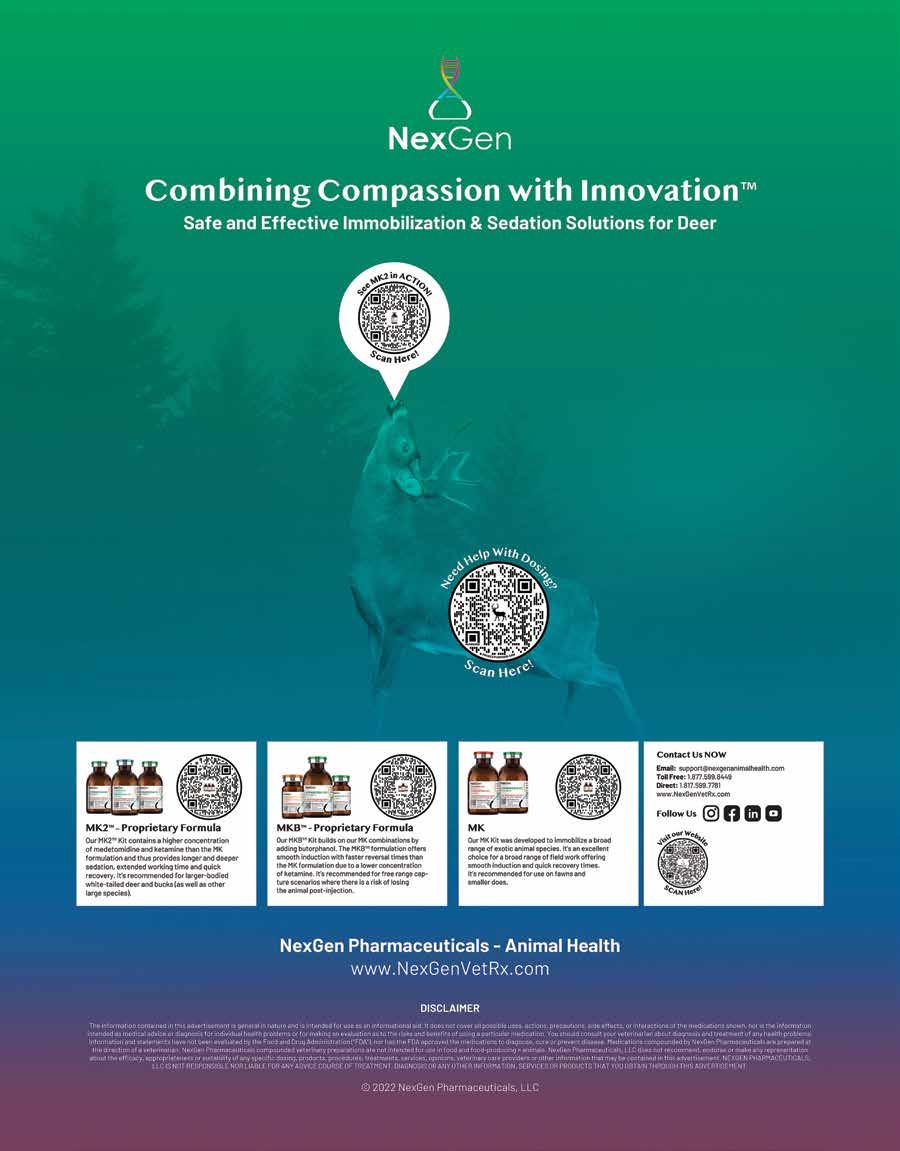
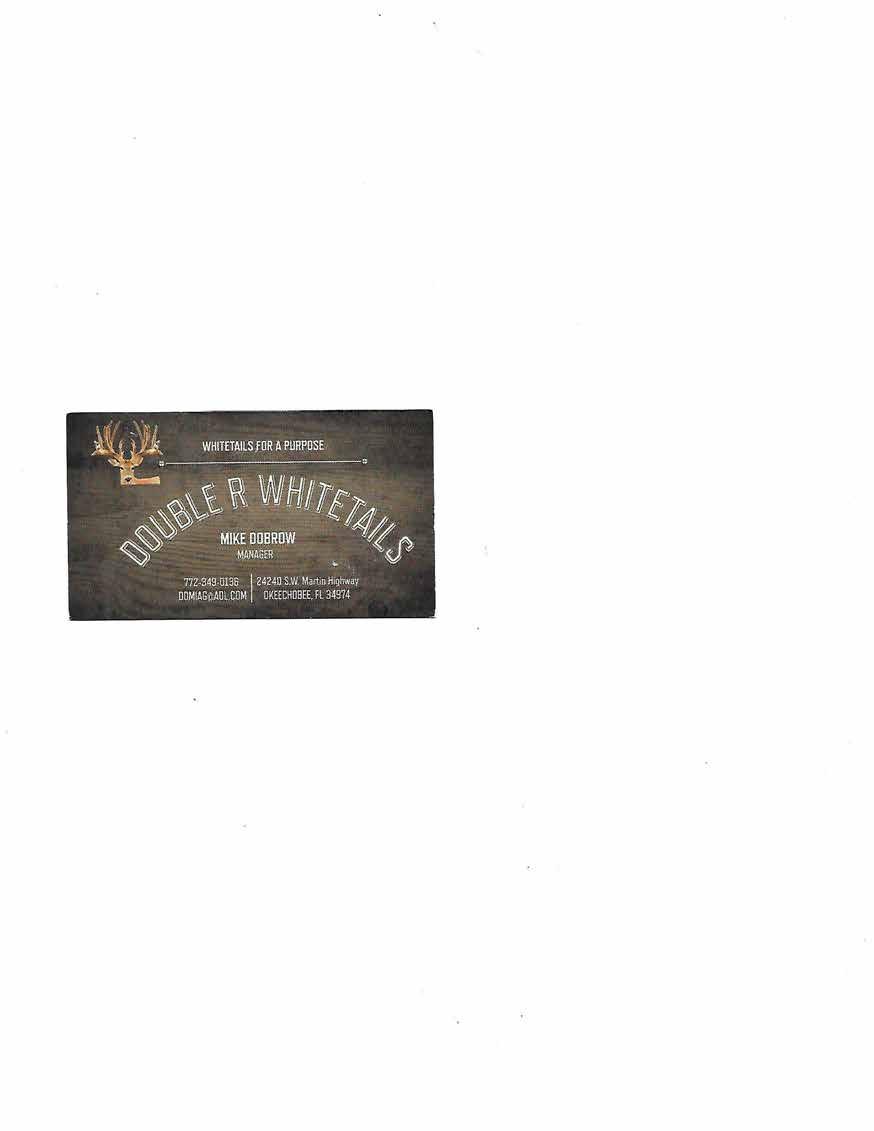
Welcome to our SeTDA members Business card spread.

This is not just FREE advertising but a way members, both old and new, can reach out to each other for your services or to buy and sell deer.


If interested in getting into future business card spreads, send your Farm or Business Cards to; info@southeasttrophydeerassociation.com.
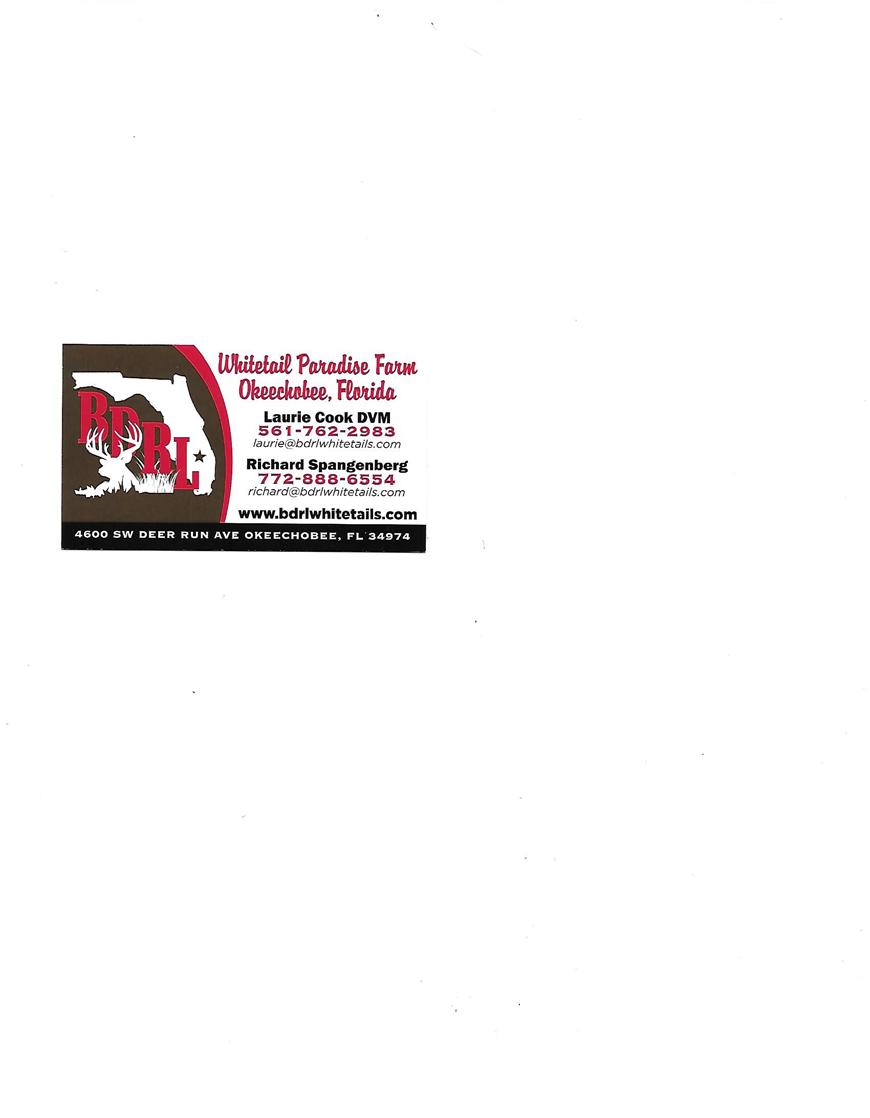
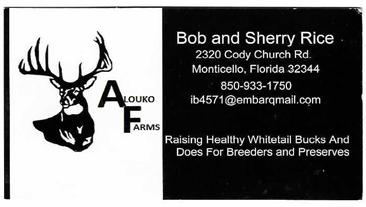

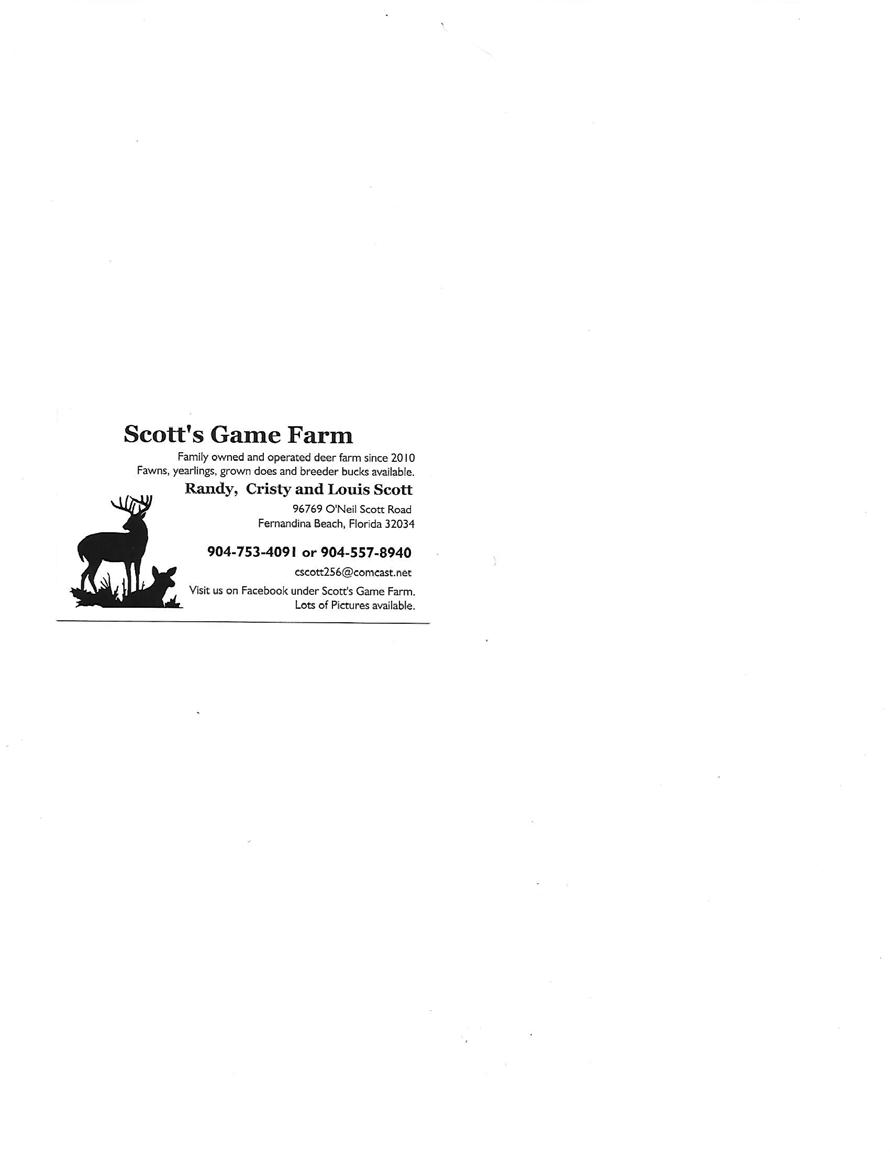
Due to the high volume of business cards we rotate the cards in each quarterly magazine. If you’re concerned that yours is missing resend your card anytime and check to see that your membership is still active.




The SeTDA wants to hear from you and show new and established deer farms and preserves who you are and where in Florida you are located. We look forward to hearing from you and creating a great advertising spread for our members!
Thank You, SeTDA BOD’s










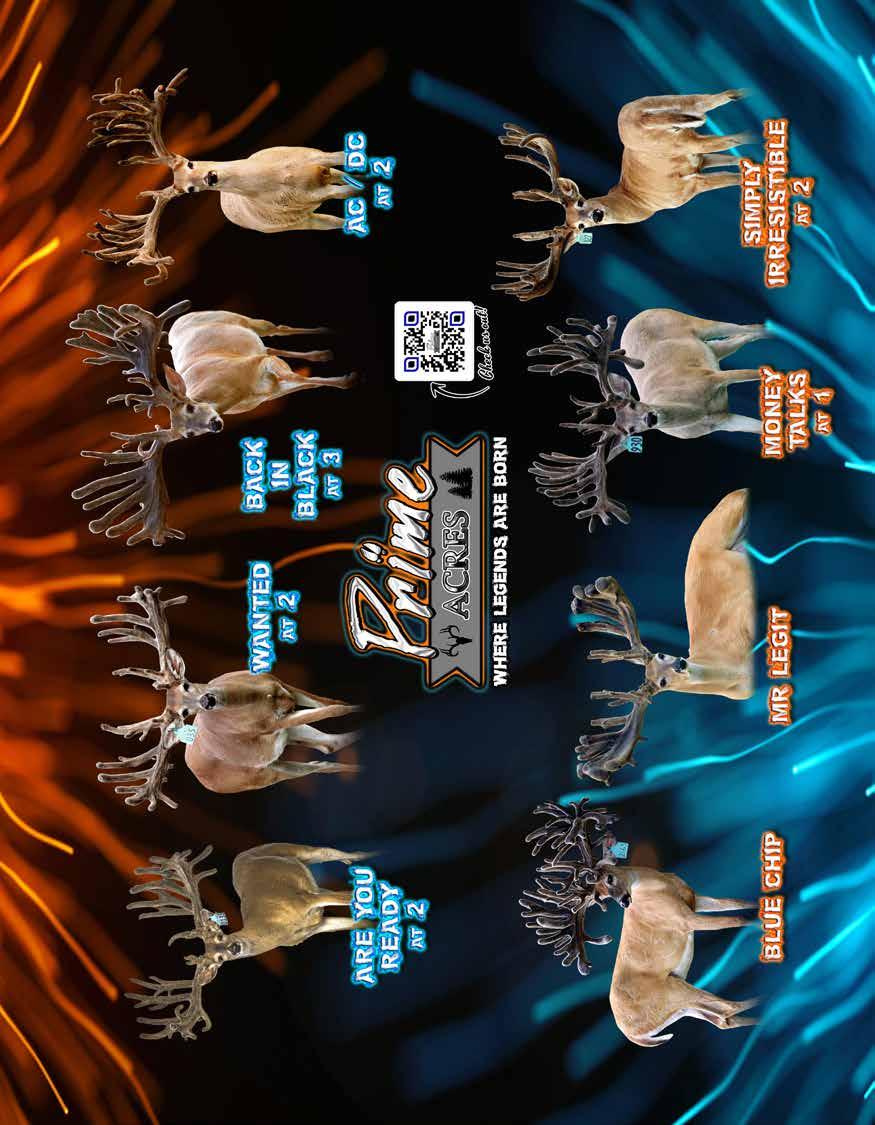


A big thank you to everyone who participated in the spring fling this year!

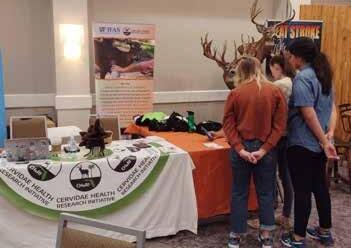
Spring Fling photos!








Autumn
Acorn

Apple Leaves
Colors
Pumpkin
Sweater
Maize
Scarecrow
Turkey Antlers
Buck Harvest
Cider
Cranberry
Hayride
Sunshine Foliage
Hibernate
Migrate
Umbrella
Raincoat
Orchard
Frost Season



Micr ochips
• USDA 15 digit ISO

• 9 digit Avid and 10 digit Euro.

Avid Reader s
• Avid MiniTracker Livestock Reader specially priced.


• Blue Tooth® option.
• Dependable Fast, Accurate read EVERY Time!
• U.S.A. made and service.
The Texas Deer Association has a long history of advocating for whitetail deer and deer rancher's rights. In this conversation the Executive Director of TDA Kevin Davis gives an update on critical information regarding the work TDA is focusing on right now!


https://www.youtube.com/watch?v=LG5tNT-t9Og

Accurate wildlife counts are critical to any operation. Lafourche Drone Services provides accurate, reliable, and affordable surveying and tracking for any type of land.

Instead of surveying from the ground we utilize drones equipped with state-of-the-art thermal sensor capability that allows us to accurately track the movement of wildlife with up to 96% precision.

Because we survey from above we never disturb the wildlife in their natural environment or disturb your land.
985-200-4280

No matter how large your land is or how many animals you may have, tracking wildlife is tough.
Our location reports provide a visual interpretation of what’s happening on the ground.








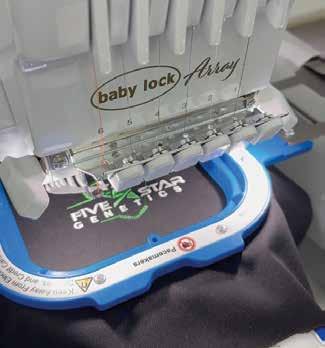


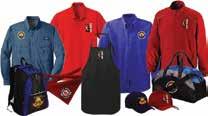




™


Rut and reduced feed intakes can bring out the worst in bucks and irritable behavior can rear it’s ugly head!

PeaceMaker is scientifically formulated to provide optimal support levels of magnesium, Vitamin B1 and inositol to help maintain a normal and relaxed disposition in cervids
Now enhanced with appetite stimulants and probiotics for digestive health
Contains no herbals nor tryptophan, eliminating concerns of unwanted side effects
Use PeaceMaker™ to help “keep the peace” during pre-rut, rut, transportation and other key times during the year












Now available in a 30 lb resealable bag and 11.25 lb pail to help fit your operation’s needs


ROBUST, FAST GI SUPPORT FOR FAWNS & OLDER DEER





Designed to quickly support normal GI health



Novel formula delivers powerful immune support


Can be used post tranquilization to help speed recovery





DIGESTIVE HEALTH & IMMUNE SUPPORT CERVIDS OF ALL AGES


Supports digestive health and a healthy immune system
Natural formula contains Encrypt®, egg proteins, enzymes, micro-encapsulated probiotics and a prebiotic

Top dress or mix in feed during fawning season, weather changes, times of stress and when top performance is desired

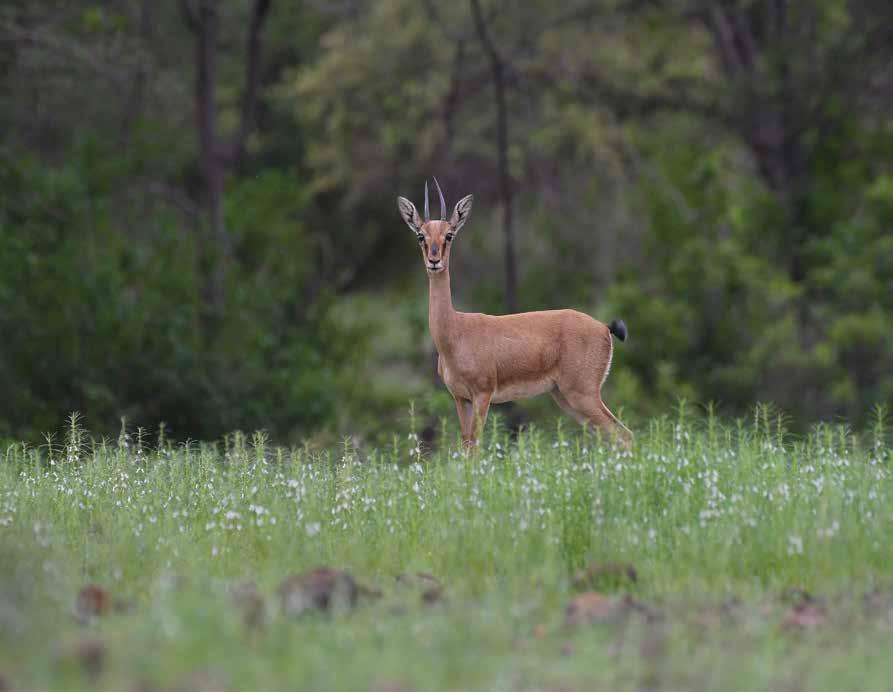


















 By: Gail Veley
By: Gail Veley
Blue Creek Whitetails Manager
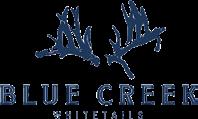
Jimmie Neeley pauses at the pen of Royal, his favorite doe on the farm he breathes life into seven days a week. As Royal approaches him, it isn’t so much the treat he’s holding that she’s interested in, but rather, the affection he offers along with it. She nuzzles and licks his hand as he strokes her neck and softly talks to her. Her sheer delight in seeing him is obvious. And vice versa. And just like the farm itself, there is a lot to appreciate about Royal, whose pedigree includes Blue Chip, Freeze Frame, Shadow and Tasha among others. This four-year-old doe is also perhaps a symbol of what is good and right in the deer industry and at Blue Creek Whitetails. Their superior animal husbandry skills combined with breeding superior genetics, finds Blue Creek Whitetails producing some of the most elite whitetails in the industry.
The sprawling 250-acre farm in Falfurrias, Texas, is home to approximately 1,150 deer including bucks and does. What that number does not include is the 400-500 fawns expected this season. And while those sheer numbers of deer may seem overwhelming from a management perspective, Neeley, who always keeps the big picture in the back of his mind, lives by this decree. “We take things one step at a time and one deer at a time,” he
explained. “You don’t only focus on the big picture. You learn to slow down and simplify and to keep your goals clearly defined. We have a great team of employees that always goes above and beyond in every circumstance.”
Neeley and his wife Kayla are as devoted as anyone could be in their positions. Yet, both realize how lucky they are to have the dedicated team of employees working right alongside them. “We have one gentleman working here that no matter what time you decide to start that day, he always the first one there. He refuses to show up second to work,” Neeley, 41, shared. “We also have an employee who’s a licensed veterinarian in Mexico. After seeing to the deer, he’s not one bit scared to work hard and pick up a weed eater or get on a tractor. He’s 70 years old and he’s amazing. All of the employees here are amazing and work together seven days a week. Every one of them is a valuable asset. We deeply appreciate everything that they do.”
Neeley, along with farm owners Billy and Alice Oehmig, also appreciate the partnerships they have on a few prized breeding bucks. These include Ice Man with Jade Webster of MVP Whitetails, Simply Irresistible and Wanted with Brad Hassig of Prime Acres as well as Are You

Ready with MVP Whitetails, Prime Acres, Jesse Boger of Limitless Genetics, Kiser Creek and Billy Sage. “With our business partners and production record, we believe we are moving in the right direction,” Neeley said. “Our customer base is growing immensely. They are extremely important to us along with building and maintaining good relationships. We do everything we can to make things right. And we are always looking to improve and make the herd better.”
In their spare time the Neeley’s enjoy going to the beach and also going to the gym to workout. Yet, coming back home to the farm is a feeling unlike any other. At the end of the day, crimson colors cascade as the perfect backdrop to a pen with 100 does thriving among evergreen live oak trees endemic to the Texas terrain. From his back porch Neeley takes the sight in, which never gets old. He lets out a grateful sigh that another day has gone well at this deer paradise. As he lays down next to Kayla and prepares for a good night’s rest, his last waking thought has been known to be “How can we grow bigger deer?” Check out Blue Creek Whitetails on Facebook as well as their website www. bluecreekwhitetails.com. Simply












